Rachel Huffmire's Blog, page 2
July 17, 2023
The Evolution of Fairy Tales

Fairy tales have been a part of human culture for centuries, and they continue to captivate us to this day. Face it, I'm a bit of a folklore junkie. From the classic stories of the Brothers Grimm to the modern retellings of Disney, fairy tales have evolved with the times and adapted to new audiences. And yes, I'm about to go on a deep dive into how they've changed based on what's popular in culture at the time. It's a really interesting look at how they reflect our values of compassion and courage over the years.
Compassion in Fairy Tale RetellingsCompassion is a central theme in many fairy tale retellings, and it often manifests in the form of empathy for the villain or antagonist. In the classic tale of Snow White, the evil queen is portrayed as a cruel and jealous woman who will stop at nothing to maintain her power. The tale of Snow White dates back to the early 19th century, and it is likely that the values it portrays reflect the cultural norms and beliefs of the time. One interpretation is that the evil queen in Snow White represents the fear of aging and the desire to remain youthful and beautiful.
In many cultures, youth and beauty are highly prized, and the fear of losing them is common. The evil queen's obsession with her appearance and her fear of being supplanted by a younger, more beautiful woman could reflect these societal values. Additionally, the queen's willingness to go to extreme lengths to maintain her power and control could be seen as a reflection of the importance of power and status in society at the time.
Overall, the tale of Snow White can be interpreted as a cautionary tale about the dangers of envy, vanity, and the pursuit of power at any cost. It highlights the importance of kindness, compassion, and humility as opposed to arrogance, greed, and jealousy.
However, in the retelling "Fairest" by Gail Carson Levine, the queen is given a backstory that explains her motivations and makes her a more sympathetic character. By showing us the queen's inner turmoil and struggles, Levine encourages us to see her as a complex person rather than a one-dimensional villain.
I feel like this represents a shift in cultural values and beliefs from the time of the original tale. In the modern era, there is a growing recognition of the complexity of human emotions and motivations. Rather than seeing people as purely good or evil, there is a greater appreciation for the nuances and contradictions that make us who we are. Instead of simply demonizing those who are different from us or who behave in ways we don't understand, there is a greater willingness to seek to understand their perspective and to find common ground.
Overall, the retelling of Snow White in "Fairest" represents a more nuanced and compassionate approach to storytelling that reflects modern cultural values. By exploring the inner lives of its characters and challenging traditional notions of good and evil, it encourages us to see the world in a more complex and empathetic way.

Courage in Fairy Tale Retellings
Courage is another important theme in fairy tale retellings, and it often manifests in the form of female helplessness vs. empowerment. In the original story of Little Red Riding Hood, the titular character is portrayed as a naive and helpless girl who is easily tricked by the wolf. The original story of Little Red Riding Hood dates back to the 17th century, and it is likely that the portrayal of the titular character reflects the cultural attitudes toward women at that time. In many cultures, women were expected to be submissive and obedient, and their roles were often limited to those of wife and mother. They were not encouraged to be independent or assertive, and their lack of agency was seen as a desirable quality.
In the original story, Little Red Riding Hood is portrayed as a young girl who is easily tricked by the wolf, emphasizing her innocence and vulnerability. This could reflect the societal belief that women were inherently weak and in need of protection. Furthermore, the story reinforces the idea that women should be obedient and submissive, as Little Red Riding Hood's disobedience leads to her downfall.
Overall, the portrayal of Little Red Riding Hood in the original story reflects the cultural attitudes toward women at the time, which were often limiting and oppressive. However, it is worth noting that the story has been reinterpreted and retold in many different ways over the years, reflecting changing cultural attitudes toward gender roles and women's agency.
In contrast, the modern retelling of "Scarlet" by Marissa Meyer challenges the old-fashioned view of women as helpless and submissive by portraying its titular character as a strong, capable, and independent young woman. Meyer's Scarlet is a skilled mechanic who runs her own farm and fights fiercely to protect her loved ones.This portrayal of Scarlet reflects current cultural views on womanhood, which emphasize the importance of female empowerment, independence, and agency. Meyer's version of Scarlet defies traditional gender roles and expectations, challenging the idea that women are limited to domestic roles or require protection from men.Moreover, Scarlet is not the only strong female character in Meyer's series, "The Lunar Chronicles". The other female protagonists, Cinder, Cress, and Winter, also exhibit traits of strength, intelligence, and independence. The series presents a diverse cast of female characters, each with her own unique strengths and weaknesses.The series serves as a reminder that women can be heroes in their own right, capable of taking on challenges and fighting for what they believe in.
ConclusionFairy tale retellings have come a long way since their origins, and they continue to reflect our changing values and attitudes towards compassion and courage. By showing us more complex and diverse characters, these retellings encourage us to be more empathetic towards others and to stand up for what we believe in. Whether we're reading a classic story or a modern retelling, fairy tales have the power to inspire us and remind us of our own humanity.
What are some observations you've made about modern retellings? I'd love to hear any thoughts you have in the comments.
Happy Reading!
July 3, 2023
There is Courage in Compassion

As a fairy tale author, I have always been drawn to stories that are steeped in themes of compassion and courage. But something that often bothered me was how compassionate characters were sometimes portrayed as passive or weak. I believe it takes a lot of courage to act with compassion, but how many people think of Snow White or Cinderella as being courageous? They were the nice girls who got walked all over, right? That's part of the reason why I love writing fairy tale retellings so much. I can explore the classic elements of these timeless stories, while exploring important themes in new lights. So, let's dive into why I believe there is courage in compassion, and why I use fairy tales to write stories about optimistic rebels who change the world.
CompassionFirst, let's talk about compassion. To me, compassion means being able to put yourself in someone else's shoes and feel empathy for them. Compassion is the perfect marriage of feeling empathy for someone and letting that motivation drive you into action. It's easy to feel sympathy, but sometimes it's terrifying to do anything about it.
Fairy tale heroes often begin as outcasts or are treated unfairly because of who they are. It's easy to feel sympathy for them, and hope they eventually get their "happily ever after" while the villains get their eyes pecked out by ravens. Right? But the element I really love is making the reader feel compassion for even the villain.
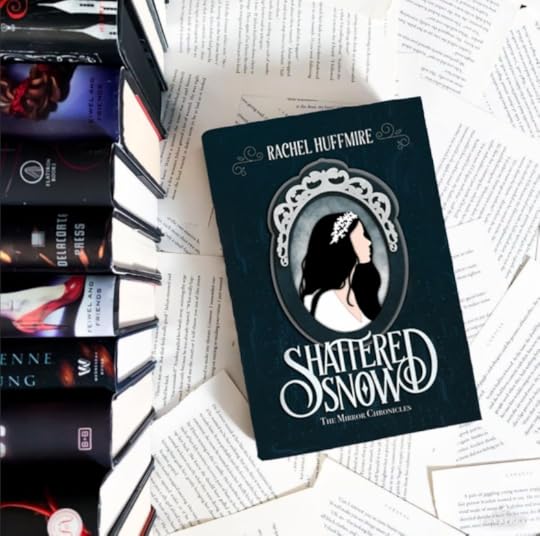
In my novel, Shattered Snow, one of the most common questions I get is "Will the evil queen get a redemption arc?" I really focused on making the queen's backstory just as sympathetic as everyone else, so that both the heroes and the villains started on equal footing with the reader. So, even as the evil queen made her descent into madness, my readers feel enough compassion for her to reach out to me and ask if she's going to be able to redeem herself.
As the author Chimamanda Ngozi Adichie said, "Empathy doesn't just extend to cute little kids or people who are like you." I couldn't agree more! And today more than ever, stories are giving voices to characters who might have been overlooked before. Reading novels helps pull us out of our own world and look at different perspectives with an open mind. It's the magic of books! We get to live more than one life by diving in with the characters.
CourageNext up is courage. This theme is all about facing your fears and standing up for what's right. In fairy tales, we see characters who go on incredible journeys, fight evil monsters, and overcome impossible obstacles. But sometimes the smallest actions require the greatest amount of courage.
One of my favorite retellings is Marissa Meyer's "Cinder," where the main character is a cyborg mechanic who finds herself caught up in a political conspiracy. The stakes are sky high, involving the fate of the world and the moon! But Cinder's true courage lies in her ability to stand up for herself and her loved ones, even in the face of adversity. Her compassion and strength comes through in almost every bit of dialogue she has with other characters. From taking on the misfit robot Iko as a bestie, to showing patience with hot-headed Scarlett, and going out of her way to rescue Cress, Cinder is constantly focusing on relationships and supporting those around her, even when she's dealing with a killer plague and shape-shifting evil queens.
 Why YOU matter
Why YOU matterSo why are these themes especially important for readers like you? Well, in today's world, you're facing all sorts of challenges and uncertainties. You might be trying to figure out who you are, navigating friendships and relationships, or worrying about the state of humanity. By reading fairy tale retellings with themes of compassion and courage, you can find hope and inspiration to overcome these challenges. You can learn that even the smallest act of kindness or the bravest act of defiance can make a difference.As the famous author J.R.R. Tolkien once wrote, "Even the smallest person can change the course of the future." In my retelling of "Snow White," for example, I wanted to show that the most powerful force in the world isn't magic, time travel, or wealth... but compassion. Bianka realizes that it's not enough to just be kind. She must act on feelings of sympathy to protect the ones she loves the most. There can be kindness in standing firm for your beliefs, for confronting monsters, and fighting back. Likewise, Courage is not just about facing external threats, but also about standing up for oneself and others in the face of danger and adversity.
So, keep reading fairy tales and their beautiful retellings. Find those themes of courage in compassion and let it empower you. Take those insights into your own life. By embracing compassion and courage, we can overcome adversity, find our own inner strength, and be that optimistic rebel who can make the world a better place.
-Rachel
June 26, 2023
Saving Winter is Here!

Hey there book lovers! I've got some exciting news to share with you all. My latest book, Saving Winter, written by yours truly, is finally out in the world, and I can't wait for you to get your hands on it. This is the third installment in the Mirror Chronicles, and is set in a world where time travel to the future is finally possible. Believe me, things are about to get crazy.
SynopsisWe follow Violette, who's fed up with waiting for the Mirror to come out of hiding and change the world. But with ITTA still in charge of time travel, every move the Mirror makes could be a recipe for disaster. Violette uncovers ITTA's latest plot against the Mirror and decides to take matters into her own hands to save her loved ones.
Meanwhile, Baigh is living the high-life while promoting the Mirror's cause, but a threat that locks down the Silos forces him to face his deepest fears. And Fleur feels trapped in the Silos, waiting for her destiny to unfold until an opportunity comes knocking, which changes everything.
If you're looking for a wild ride, then this is the book for you. I can't wait for you to read the first chapter and dive into this world where time travel is real, and everything is up for grabs. So, what are you waiting for? Let's get reading!

Mirror Silo Headquarters, Oklahoma, United States, Western Union
19 December 2072
Violette brushed aside a stray strand of lavender hair from her eyes as the dinner bell echoed through the open classroom door. She stretched, trying to ignore the warm aroma of ham and rolls that wafted in from Rusha’s kitchen. Supper would have to wait until Vi had finished tidying the assimilation room.
The hands-on learning center had three banquet tables arranged in rows. Modern electronics and appliances lay scattered across each table: televisions, microwaves, electric pianos, lamps, and more. Now that class was finished, it was her job to place everything in its designated spot on the shelves lining the walls.
The first lesson with historical refugees always left the classroom in shambles. Most of the students tentatively interacted with modern devices in the beginning. But once their overwhelm and fear subsided, they became like curious toddlers, exploring, manipulating, and sometimes even dismantling the tech. Assimilation classes released the refugees’ curiosity before they stepped out into the real world.
Violette picked up a grease-stained toaster and groaned in frustration.
“What did they break this time?” Rouge looked up from where she worked across the room.
“Someone jammed a tablet in here.” Violette pointed at the overstuffed bread slot.
“How on earth?” Rouge’s signature snort punctuated her laugh.
Violette bit her bottom lip, reached for a screwdriver, and tried wedging it into the appliance. She winced as the tablet’s display made a crackling sound, like gravel ground beneath a shoe. “I rarely blame them for being curious, but this is just malicious.”
Rouge stepped closer and peered into the toaster. “It’s better that they make these mistakes here rather than above, right?”
Violette sighed and nodded. Anytime the Mirror rescued someone from their unfortunate place in history, the faeris spent three weeks training them on the basics they’d need to know before entering the modern world. In the past, Keltson had shuffled people around in the past, saving them from dismal timelines, and setting them on new trajectories. But ITTA was combing history for any trace of his interference these days. The only place to relocate them was the present day, where ITTA didn't suspect.
And Violette was a part of it all—training and supporting refugees on how to succeed in this new world. But there were obvious risks. If anyone got caught gaping at electronic toothbrushes and doorbells, they could draw suspicion that might lead ITTA right back here, to headquarters.
So, Violette let people make mistakes like shoving tablets into toasters in the safety of the silos, instead of in their future homes.
Violette finally freed the edge of the tablet from beneath the metal lip of the toaster, and the device popped up like a piece of bread. Pursing her lips, Violette ran her finger over the top corner of the screen. A spiderweb of cracks laced the glass. She pressed the power button, and the display lit up. Unfortunately, a black void filled the broken corner.
“That’s a shame.” Rouge clicked her tongue.
“I’ll have to drop it off at the tech bay with Tia. I’m sure she’ll be thrilled.” Violette tested the touch screen by tapping on a news app. A bold front-page headline blared up at her.
ITTA’s Newest Offensive Line: Bounty Hunters
Her breath caught, and she skimmed through the article, scanning segments that mentioned recent civilian protests outside of ITTA headquarters. The current director, Aiguo Huang, had just announced a new department dedicated solely to finding The Mirror. Her finger swiped through the article, revealing that there would be a new crime investigation channel for citizens to live-stream along with the strike team as they pieced together hints and clues. The piece ended with a chilling quote.
“An entire team of mercenaries devoted to hunting down the Mirror wherever he may hide? That’s right. Time-traveling bounty hunters. And we get to sleuth right along with them. What has the world come to?”
Vi’s stomach tightened as she read the article, and she placed a hand over it for comfort. “I have to show Keltson.”
Rouge, who had been reading over Violette’s shoulder, nodded. “I’ll finish up here. Go.”
Violette hurried out the door and into the main silo. She ascended the spiraling scaffolding that led up each of the five stories. Each landing had a hall of tunnels leading to various control rooms. Keltson had repurposed the old cold-war missile silo tunnels into dormitories and gathering spaces like Rusha’s kitchen, Tia’s tech bay, and Ammond’s management office.
Four floors later, Violette reached Keltson’s control room. She took a deep breath to compose herself before entering.
Inside, Bianka looked up from folding a pile of clean clothes meant for the incoming refugees who would likely step through Keltson’s mirror any moment now. Whenever new arrivals came in, Bianka was the first to greet them. She saw to their basic needs, offering them necessities and guidance to their rooms. The job suited her. Her calm demeanor and soft brown eyes worked soothing magic on anyone who stepped through Keltson’s Mirror.
“Violette, how are you?” Bianka asked, a smile spreading across her face.
“I need to see Keltson. Urgently,” Violette said.
Bianka hesitated and glanced at the “do not disturb” sign above Keltson’s consulting room—a dark closet that he used while directing Charul’s time travel rescue missions in the past.
Normally, Violette would wait for Keltson to finish, but this information could jeopardize everything Charul was doing.
Violette stepped firmly toward the door and knocked.
Bianka stood. “He’s running an extraction mission with Charul. You shouldn’t interrupt them.”
Violette pounded harder.
The door flew open, and Keltson squinted out at Vi. His eyelids drooped like he had been working in the dark for days on end. The light of six monitors lit the small space behind him, illuminating a trail of empty energy drink canisters strewn across the floor.
“ITTA is changing tactics.” Violette shoved the tablet toward him, clearly displaying the article.
Keltson frowned as he studied the article. Then he returned the tablet. “I shouldn’t be interrupted by this.”
Violette straightened in surprise and pointed to the headline. “If Charul is in danger, bringing him home is in your best interest.”
Keltson ran a hand across his face. “The fact that there are now bounty hunters in the mix doesn’t mean ITTA is any closer to finding us.”
Violette set her jaw. “The only reason he thinks he’s safe back there is because he knows all the other agents who currently time travel. He doesn’t recognize these new recruits.”
“Thank you for your opinion, but I know what I’m doing, Violette. We have plenty of protocols in place.” Keltson pursed his lips, obviously trying to keep his temper in check.
Violette ducked her chin back. “ITTA continues to make moves to find us. We only make changes once we’re backed into a corner. We should act now, while we have a heads up.”
“I’m not afraid of ITTA.” Keltson shook his head.
“Then make the first move! We’ve been working in this hole in the ground for two years. ITTA has protesters on their doorstep. You could use this moment in your favor. They’ve taken this too far,” Violette said.
Keltson scowled. “I won’t turn into an antagonist.”
Violette leaned in. “Fine. If you don’t want to compromise your values, then give someone else the tools to take ITTA down from the inside.”
Keltson’s gaze darted toward Bianka. He spoke through clenched teeth. “We already talked about this, Violette. The answer is no.”
Vi pressed her hand against the doorframe. “But if we just helped Lilia, she could…”
Keltson grabbed her wrist and pulled her into the control room, shutting the door behind them. His eyes were dark and intense as he raised a finger to her face. “Never mention Lilia in front of Bianka.”
Violette ripped her arm free from his grasp. How dare he be so brusque with her!
Keeping her voice sharp and level, she said, “I understand your reasons for disliking Lilia, but the woman who attempted to kill Bianka is gone. The version of Lilia that’s trapped in ITTA headquarters did everything in her power to save Bianka’s life. She probably still cares about her! Have you ever wondered why ITTA doesn’t have more information about you? Lilia’s most likely protecting Bianka by withholding what she knows about the Mirror. You’re accusing Lilia of crimes she never committed.”
Keltson’s eyes narrowed at her words. “Lilia was never the selfless being you just claimed she was. From the beginning, she strayed from the plan to serve herself. Giving any amount of power to someone so self-centered is a dangerous game.”
“Lilia has been trapped inside ITTA for four years. She probably knows more about their motives and tech than Tia does. With a mind like hers—”
“I know precisely what a mind like hers is capable of.” Keltson took a deep breath through his nose, trying to stay calm. “A person’s essence remains the same in every timeline, no matter how many times we re-write their story. Lilia is too self-interested to be an asset. She’s a genius, yes. But a ticking time bomb.”
Violette leveled a stern gaze at him. “This isn’t what I signed up for, Keltson. You’re settling for crumbs when there are universal laws to be changed. We could make a difference everywhere instead of merely creating happy endings here and there. Everyone could have a shot at living their best life instead of just a lucky few. Why limit your influence to people from the past? What about those living here and now? Don’t they deserve the same protection you provide others?”
Keltson studied her as if attempting to read her intentions. His mouth remained pressed in a firm line. “Be careful, Violette, you’re beginning to sound just like her.”
Violette froze. Did he really think that?
Keltson continued. “I saved Lilia from a life she wanted to leave behind, but she used her opportunity to manipulate Bianka’s timeline. Lilia already had a chance at redemption. I won’t give her access to time travel ever again.” Keltson opened the door. “Now if you don’t mind, I need to assist Charul.”
Violette squinted against the sudden light outside his office. A jumble of emotions welled up inside her, but she remained outwardly calm. She lifted her chin and said, “We are going to regret it if you don’t do something about ITTA.”
“You are dismissed.” Keltson’s tone left no space for objections.
Violette stepped out of his consulting room. She walked past Bianka without looking at her. The Mirror had more work to do in the world. This fight was worth it. No matter what Keltson thought, she knew she wasn’t like Lilia. She was a part of the Mirror. She had been for four years now. But it was too much to ask all these people to stay hidden below ground in Oklahoma indefinitely, especially when they could make a lasting change.
Keltson just wasn’t being honest with himself about their safety. And Violette worried that the illusion of control was as dangerous as the lack of it. If only Keltson saw things the way Violette did.
He couldn’t afford not to.
April 24, 2023
The Magic of Springtime Fairytales: Stories of Transformation and Beauty

Spring is finally here on the west coast where I live, and it feels like stepping into a fairytale. The orchard outside my window is bursting with blossoms, and I've been spending my days planting new seedlings and tending to my garden. As I've been enjoying the emergence of spring, I've also been thinking about fairytales that capture the essence of this season of growth and renewal.
Tales like "The Secret Garden," "The Frog Prince," and "The Princess and the Pea" all have a magical quality that seems to mirror the feeling of the weather warming, and the promise of new things around the corner.
In fairytales, this theme of new beginnings is a common one, with many protagonists finding fresh starts and second chances in their stories. Fairytales are full of examples of characters who start with humble beginnings and go on to live happily ever after. They are stories of new beginnings, of hidden beauty, and of the transformation that comes with hard work and dedication.
Just as the seeds we lay for our future lay dormant for the winter, our consistent, small efforts are like seedlings that will blossom into happily ever afters. In this blog post, we'll explore some of my favorite springtime tales and share some ideas for readers to usher in this season of renewal in a fairy-tale way.
New BeginningsOne of the most common themes in fairytales is the idea of starting over. Whether it's Cinderella escaping the clutches of her cruel stepmother, or Rapunzel finding a new life outside of her tower, fairytales often feature characters who are given a fresh start.
In the story of "The Little Mermaid," a beautiful young mer-princess dreams of having an immortal soul. After talking with her grandmother, she thinks the best way to achieve this is to earn the love of a human, who will share a part of his soul with her, and grant her life in heaven after she dies. But when she fails to get the prince's love, her sisters plead with her to return to the sea before she dies. They offer her a dagger and say that if she kills the prince, she can return to the sea. But the mermaid refuses and dies, turning into foam on the sea.
This is where most people think the fairytale ends in tragedy, but the truth is there are a few sentences at the end that most people gloss over completely. The wind spirits see the little mermaid floating as foam on the sea, and pick her up, telling her that her virtuous and unselfish decision earned her a place in heaven. It's actually a happy ending, as she gets her initial wish to have an eternal soul, and suggests that new beginnings are possible when we stay true to the things we know are right and true.
The process of starting over is often not an easy one, and fairytales reflect this. The heroes and heroines of these stories often face great obstacles and challenges along the way. In "Beauty and the Beast," for example, Belle must overcome her initial fear and disdain for the Beast, and find the inner beauty beneath his exterior appearance. Similarly, in "The Ugly Duckling," the protagonist must overcome the ridicule and rejection of those around him, and learn to embrace his true identity.
Fairytales remind us that new beginnings are possible, but they require courage, resilience, and a willingness to persevere. By taking inspiration from these stories, we can find the strength to start anew in our own lives.
 Seeds of Renewal
Seeds of RenewalAnother common theme in fairytales is the idea of planting seeds for the future. In stories like "Jack and the Beanstalk" and "Rumpelstiltskin," characters take small actions that eventually lead to great rewards (or consequences!) These small efforts may seem insignificant at first, but they eventually blossom into something much larger.
This metaphor of seeds and growth is a powerful one, and it's one that we can apply to our own lives. I've been learning this lesson a lot lately. About a year ago, I made a small production calendar, keeping small and consistent goals in my radar. I've been fitting writing in between the cracks in life, a writing sprint here, a marketing effort there. But I had a difinitive plan and deadlines I had set for myself. This kept everything rolling along and all of a sudden, last week, all at once, they all started paying off. The book I had been working on for a full year was suddenly edited, formatted, and ready to publish! Another book I had been daydreaming about for just as long suddenly had the words "The End" tagged onto the last page. And I got the best news ever about a secret project that I'm hoping I can announce soon! For so long it felt like I wasn't making fast enough progress, then suddenly it was all complete at once! So, keep planting those seeds, and don't worry if it feels like "not enough". Because you'll get there!
Fairytales as MetaphorsOne of the things that makes fairytales so powerful is their ability to serve as metaphors for our own lives. Just as the characters in these stories face challenges and obstacles, we too must navigate the ups and downs of our own journeys. By taking inspiration from the lessons of these stories, we can find the strength to overcome our own challenges and pursue our own dreams.As the snow melts away, and the days get longer, we can't help but feel a sense of renewal and hope for the future. Just like the protagonists in our favorite fairy tales, we too can find new beginnings and fresh starts.
One such example is the story of Cinderella. She started her story as a mistreated and neglected stepdaughter but through her kindness, perseverance, and the help of her fairy godmother, she was able to attend the royal ball and capture the heart of the prince. Her new beginning allowed her to escape her oppressive situation and find true happiness. I loved playing with this story in "Sculpting Fables", digging into the real-life inspiration of Cinderella from ancient Egyptian lore.
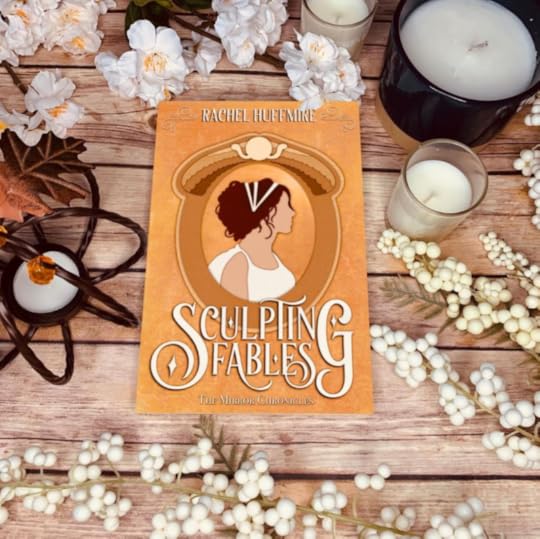 Bringing Fairy Tales Into Your Life
Bringing Fairy Tales Into Your LifeI have loved the surge in "cottage core" lifestyles, and even though I'm not hardcore like some of the incredible influencers out there, I've started integrating little pieces of this into my life to make my life feel just a little bit more magical.
In fairy tales, nature often plays a prominent role in symbolizing new beginnings. The arrival of spring brings with it budding flowers, green grass, and warmer temperatures. These natural elements remind us of the potential for growth and change. I've started decorating my home with fresh flowers, planting a small vegetable garden in the back yard, and even bought some potted flowers for my front porch. Taking a moment to water my seedlings every morning has brought a little peaceful reset into my day that I didn't realize I needed.
Another way to bring fairy tale magic into our lives is through literature. Reading a favorite fairy tale or discovering a new one can transport us to a world of wonder and possibility. What are some of your favorite springtime fairy tales? Leave them in the comments so we can gush about them!
It feels like the winter was the most brutal we've had in a while. So, as we emerge from the darkness of winter and embrace the warmth and light of spring, let us remember the lessons of our favorite fairy tales. Just like the characters we love, we too can find new beginnings and happy endings. With patience, perseverance, and a little bit of magic, anything is possible.
Rachel
April 17, 2023
How to Write Compelling Queries

Writing a query letter can feel as daunting as drafting an entire book. How can you distill all the beautiful complexities of your book down into just a few sentences? Will my query sit at the bottom of a slush pile forever? How do I stand out?
I used to work as an acquisitions editor, which means I got to read queries and submissions daily. But, I’ve also been on the other side of submissions. As an author, (to this date) I have received 72 rejection letters, 2 partial requests, 5 full requests and 3 book contracts from my own queries.
When I sent my first query in 2015, I remember feeling nervous at how I would handle the inevitable rejection letters. Someone told me to expect 100 “no’s” before I got a “yes”. I told myself that I wasn't going to quit querying my manuscript until I got 100+ no's. So, each time I got a rejection, I took a tally and felt excited that I was getting closer to my "yes".
I’ll admit, rejection still hurts even with a good perspective. Especially when you get a form rejection on Christmas Eve (even if I did feel sorry for the agent who had to bring work home that day). But, it helps when you remember that querying is partially a numbers game. Perfectly publishable manuscripts are rejected every day. Don’t give up on your book before it reaches the right hands. Agents and editors are rooting for you to become their next favorite author!
As I honed my own query over the years, I realized that there was definitely a recipe to crafting a submission. Now that I’ve read so many different voices in a variety of query formats, it’s easier than ever for me to see what makes a query letter stand out in the slush pile. In this article, I'll give you formatting and content advice, then I have a few wonderful volunteers who submitted queries for critique. I'll go through these (already solidly written) critiques and point out what they did right and how they could make it even stronger.
Let's get started.
 1. Contact information
1. Contact informationPlace your contact information at the top left side of your letter. Make it look something like this:
Name
Address
Website (if you have one)
Phone
Question: Should I still include this information if agents/editors have an online submission form?
Answer: Yes. Always. Many writers assume that including their contact information on top of the letter is redundant. That redundancy is a good thing. Nothing was more frustrating for me than having a full manuscript request returned as undeliverable because the author typed their email address wrong. (This once happened to me three times in two months.) If we didn't have your email, we couldn't ask for your novel. You don't want to miss a publishing opportunity over a simple typo.
2. Professional greetingI recommend starting with a formal, professional greeting.
"Dear Mr. Petersen," or "Dear Ms. Wilson,".
Some websites recommend using a colon (:) after your greeting, claiming it’s even more formal and respectful. You can do that if you feel the need to, but a simple comma was fine for me.
If the agent/editor responds back to you with: "Hi Rachel," then it's appropriate for you to match their tone and speak to them on a first name basis. But until then, keep things respectful.
Next, make sure you spell their name correctly.
"Dear Mr. Petersen. Or was it Peterson? Oh, goodness. Pederzon. I'm glad I checked."
Getting an agent/editor’s name right is one step towards showing you've done your research.
3. The introduction paragraphAs an acquisitions editor, I genuinely appreciated when a query's first sentences pointed out why the author was querying me. Your introduction can be something as simple as saying we connected on Twitter, that they read my blog posts, knew what genres I was interested in, or appreciated my publishing house's mission statement. These first two sentences will have to be customized for every query you send out. And yes, it's worth it.
In that same paragraph, list the title, genre, age group, word-count, and any comparable titles. (You’ll see some good examples of this below.) This information is crucial for agents/editors. They know what their agency/publisher is currently looking for. Also, If they see a genre that they’re not a good fit for, they can easily pass it along to another editor who loves and specializes in that genre.
 4. The story paragraph(s)
4. The story paragraph(s)You have up to two paragraphs to pitch your story idea. I know that sounds impossible to condense your entire work down to that. But, I'm here to tell you that you certainly can do it, it just takes practice. Start by answering these questions in a third-person narrative form:
1. Who is my protagonist?
Give us their name, age and their most defining trait: Brody, a 12-year-old class clown... Nina, a 34-year-old golfing instructor...
2. What do they want?
This should be the need or desire that drives them through the entire story. It should be at the root of every decision they make.
3. Why can't they get it?
What obstacles stand in their way? These should feel insurmountable.
These three points should be in your first paragraph. This introduces us to the character on a deeper level, ensuring that your reader is invested in continuing. The second paragraph should answer the next two questions:
4. How does your protagonist try and fail?
Be specific here. Many times authors say something like "After Aladdin's harrowing escape..." That didn't do a lot for me. I wanted to know that he "narrowly escaped a collapsing cave filling with lava while riding a magic carpet." That kind of specificity pulled me in immediately.
5. How will your protagonist have to change?
Don't give up the ending. Instead, leave a question hanging in the air. For example, in my query for Granted: Curse of the Emerald Jinn (which ultimately got a publishing contract), I ended with the thought that "If Liam escapes the deadly curse, it will unleash a bloodthirsty jinni from his cage..."
This is what I like to call "The impossible choice", and it's a winner in any query. Instead of giving us the "Will they defeat the bad guy?" (Because we all know the slipper will fit Cinderella in the end), make your final sentence about them choosing between what they want and what they need. So, in this case, I detailed how Liam had to decide to stay safe (but trapped in another world for the rest of his life), or escape (and release a terrible Jinn on the world) instead? Try highlighting a moment where your character must make an impossible choice and we'll be dying to know more.
In short, if you can get your reader to understand your compelling character arc, you're on a good track.
Now that you have the basic outline for what to include in your paragraphs, build out the synopsis portion of your query. Pick dynamic words, and give us a glimpse at your tone, worldbuilding, and literary style. Let us hear your voice through it rather than making a bullet point synopsis.
4. Marketing and bioYour last paragraph is your chance to show that you're a professional and already involved in marketing your books. Even if you don’t have a backlog of previous publications, you can include details that convince us you are the best candidate to tell this story. Some points to focus on:
Education or background in topics that apply to your novel. Social media platforms you're already involved in. Personal website or blog links. Awards won. Previous publications.Finish with a short expression of gratitude, sign your name, then work up the tenacity to send it off your dream agent/publisher!
Okay! Now, who is ready for some examples?!
 Examples:
Examples:I had some wonderful Twitter followers who donated their queries as examples. I’ll include their paragraphs and make notes of what they do right and how they could make it even better. I don’t have the personalized lines from the beginning of their queries, although it was included and done well. When you save your query, you want to save without the personalization and then add that every time you prepare it for a new submission. This gives you an easy template to work from and will save you a lot of time as you send out new batches of queries.
Example #1:Introduction Paragraph:
STARVATION is a 52,000 word Young Adult contemporary novel. It would appeal to fans of Laurie Halse Anderson's WINTERGIRLS and SPEAK, Jay Asher's 13 REASONS WHY, and Emery Lord's WHEN WE COLLIDED.
What she did right: This novel is a great length for its genre. I love the titles she compared it to because they were current, within the same genre as her title, selling well, and had a consistent tone. I immediately trust that this author is well read in her genre.
Tips to tighten: This paragraph is informative, formatted perfectly, and brief. Perfect.
Story Paragraph 1:
16-year-old Wes McCoy is not the favorite child. He does not have a wrestling scholarship to Stanford nor does he live up to the family legacy as an athlete, unlike his brother, Jason. But when Jason dies in a car accident on the way to the state high school wrestling championship, Wes turns to food to give him the control over his life he didn't have before, and the kind of success he never tasted.
What she did right: The first sentence is a beautiful way of introducing the character. She included his age, name, and a nuanced introduction to his insecurities. She didn’t directly say that he’s insecure, she showed me. Absolutely wonderful. The concept immediately sets a desperate tone that draws me in.
Tips to tighten: Saying so much about what Wes is “not” says very little about what he “is”. After the first sentence, I would like to see why he isn’t an athlete “unlike his brother, Jason.” I think mentioning wrestling twice is unnecessary and can free up some words for a deeper focus on Wes. The phrase “turns to food” made me think he ate for comfort. But as I read further I had to re-align my idea of Wes as a sympathetic eater to an anorexic. When you have so few words to work with, you want to ensure you lead your reader in the right direction. Since anorexia is part of Wes’ “try/fail” cycle in coping with his brother’s death, I suggest focusing mainly on the problem of Jason’s death and not introducing the eating disorder until the second paragraph.
Story Paragraph 2:
Told through alternating past and present chapters revolving around Jason's death, Wes must come to terms with more than Jason's death. There's Caila, a defiant girl who introduces him to the painful pleasure of starving. Plus Collin, Wes's best friend who speaks in Shakespearean insults and with whom his relationship is irreparably damaged. But most of all, Wes must take back control from his eating disorder as he learns more about himself and Jason's accident, before he loses his life and those closest to him.
What she does right: “The painful pleasure or starving” is such a wonderful expression of voice. The introduction of Caila as a catalytic character progresses the plot in a fantastic way.
Tips to tighten: The first sentence is unnecessary. Remember, the purpose of these story paragraphs are to develop your character’s arc, not your novel’s format. I would like to see how the new character, Collin, relates to Wes’ problems. Does he influence a second choice in Wes’ try/fail cycle? How is their relationship irreparably damaged? Give specifics. The final sentence should show Wes’ impossible choice, rather than a choice between an unhealthy trait and survival. It’s easy for us to assume the protagonist will triumph. You don’t want your reader to guess the ending. Instead, focus on his choice between facing two equally terrifying fears.
Marketing and Bio Paragraph:
I am pursuing my degree from Swarthmore College in Neuroscience, English, and Spanish. As a part of Neuroscience, I research and study mental health including eating disorders. I have published in The Blue Route Literary Magazine and The Blue Nib as well as in academic journals. I also run my own blog on writing.
What she does right: This author shows how her accolades contribute to her writing this story. She has a list of previous publications and shows that she’s already involved in networking within the writing community by running a blog on the subject.
Tips to tighten: I would like the direct link to her blog so I can visit it to learn more.
Example #2:In this next example, the story paragraphs come before the introduction. This is also an acceptable format. Do whatever feels more natural to you.
Story Paragraph #1:
As a college graduation present to himself, Tom Dassler decides to fulfill his dream of exploring the untamed jungles of Costa Rica. He has no idea, however, that there has been a recent spike in vicious animal attacks against those who venture those dark jungle paths.
What he does right: The character introduction gives me a sense of a naïve man about to encounter a wild adventure. I like that my mind already predicts a likeable person. The character wants to explore, and the obstacle is already established. This paragraph is off to a strong start.
Tips to tighten: All of the sentences in these paragraphs are about the same length. Adding variety will make it flow more naturally. Making the second sentence short and punchy will make the danger feel more threatening.
Story Paragraph #2:
After days of camping in the jungle, his hiking party is suddenly surrounded by mutated monsters. Tom is only spared because his beautiful and slightly goofy jungle guide, Natalia Silva, transforms herself into a majestic puma to fight off the beasts.
Now Tom, with the help of Natalia and her family of Latin American werecats, must figure out his new place in this world of monsters and morphers. They've got to find a way to stop the attacks and remove the sinister creatures from the earth, all while navigating the complicated hierarchy of werecat life, as enforced by Natalia's jaguar shifting brother, Gabriel.
What he does right: The initial obstacle to his motivation to explore and the setting are both really interesting concepts. The introduction to the new character is engaging and well written.
Tips to tighten: I want specific details about the mutated monsters. Are they a science experiment gone wrong? Are they animals that magically changed? Are they mythological creatures? That detail will give me an idea if this is fantasy or science fiction. Also, how does Tom face an impossible decision in the end? Will he have to choose between his desire to explore and his desire to help this new friend? Does it run deeper than that?
Introduction Paragraph:
THE JUNGLE NEXUS (97,300 words) is an urban fantasy adventure in the same vein as I AM NUMBER FOUR and MOON CALLED by Patricia Briggs but with a Tarzan meets Stephen King vibe.
What he does right: He listed all the facts an editor/agent needs to see. I love his “Tarzan meets Stephen King” comparison. It made me smile and immediately drew me in.
Tips to tighten: This paragraph needs to be divided into two sentences. As for the book comparisons, I AM NUMBER FOUR is YA, but for this protagonist to be a college grad is a little old for a YA protagonist. MOON CALLED feels more appropriate.
Marketing and Bio Paragraphs:
I received a Bachelor of arts degree in English with an emphasis on creative writing from The University of California, Irvine. I minored in Spanish and have lived nearly four years in Central and South America. I wrote THE JUNGLE NEXUS while living in Costa Rica with my wife. This is my first novel and I look forward to exploring the series further.
Thank you for your consideration,
What he does right: He has a degree in creative writing, but I also love that he wrote this book while living in Costa Rica. I can only imagine the depth of detail that he will put into the setting descriptions. It also gives me faith that he will get the cultural and character details right. Personal background is a wonderful qualifier.
Tips to tighten: Even if you are pitching your debut novel, or don’t have any other publications, list the things that show you are actively seeking professional betterment. Are you a part of a critique group? Have you attended any conferences? Did you study under professors with published works? You can also show how you are working to build a brand around your name. Do you have followers on Twitter, Instagram, or Facebook? Do you have a following outside of writing that could translate to sales? Do you have connections within the industry that could land you a celebrity blurb, or other promotional pursuits?
I hope this article helps you in crafting your own queries! I’m looking forward to reading your book someday!
Happy Querying!
Rachel
April 3, 2023
Support Your Favorite Authors Through Library Requests

As an author, one of the greatest joys is knowing that readers are enjoying your work. That's why it's important for authors to not only write great books but also to ensure that their books are accessible to readers. One way this happens is when readers like you request their local libraries to carry copies of their favorite authors' books!
Libraries have always played a vital role in society by providing access to books, knowledge, and resources for everyone, regardless of their financial situation. For many people, especially those who cannot afford to purchase books or access them digitally, libraries are a lifeline to the world of literature.
And when I have asked Librarians what the biggest factor is in what convinces them to purchase a book for their catalogue, almost all of them say "when a patron submits a request." That means that YOU have the biggest influence on what shows up on your local libraries shelves.
By requesting your favorite author's books at your local library, you can help ensure that more readers have access to their stories. It's a simple and free process that can make a big difference in your community. And it's also a plain awesome way to support the creatives you love most.
Never requested a book before? Here's how you can do it in three easy steps.
Step 1: Find your local libraryThe first step is to find your local library. You can do this by searching online, or using your phone's GPS app to search in your community. Once you've found your library, take note of their contact information.
Step 2: Ask a librarian to order the bookThe next step is to ask a librarian to order the book you want to read. You can do this in person, over the phone, or by using your library's online request form. Be sure to provide as much information about the book as possible, including the title, author, publisher, and ISBN number. The more information you provide, the easier it will be for the librarian to find and order the book.
Step 3: Wait for the book to arriveOnce you've made your request, the library will take care of the rest. They will order the book from their supplier and add it to their collection. Depending on how busy the library is, it may take a few weeks or even a few months for the book to arrive. But rest assured, the library will notify you when the book is ready for pickup.

Requesting books at your local library is not only a great way to support your favorite authors, but it's also a way to support your community. Libraries are often the only place where people can access books, especially in areas where there are few bookstores or where online access is limited. By requesting books at your local library, you are helping to ensure that everyone in your community has access to literature.
Plus, libraries offer more than just books. They are often community centers that offer a wide range of services and programs, from computer access to job training to children's storytime. By supporting your local library, you are supporting the community as a whole.
In addition to supporting your community, requesting books at your local library also supports the publishing industry. When a library orders a book, they are essentially placing a bulk order, which can help support the author and the publisher. This can also help the author's book gain more visibility, which can lead to more sales and a wider readership.
But, keep in mind that libraries often have limited budgets and can only order a certain number of books each year. By requesting your favorite author's books, you are letting the library know that there is a demand for their work. This can encourage the library to order more copies of the book or to order more books by the same author in the future.
In conclusion, requesting books at your local library is a simple and effective way to support your favorite authors, your community, and the publishing industry as a whole. It's a free service that can make a big difference in the lives of readers everywhere.
Don't forget, you can always request a futuristic fairy tale from my catalog. Check out my list of books here for some inspiration.
Happy reading!
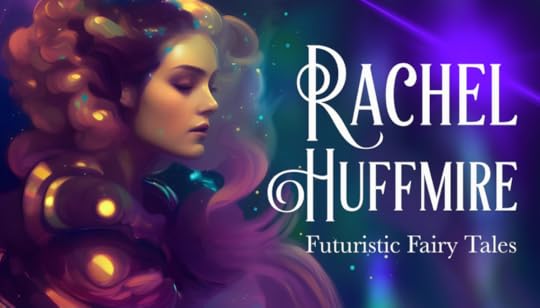
January 8, 2023
Happy Birthday Shattered Snow!
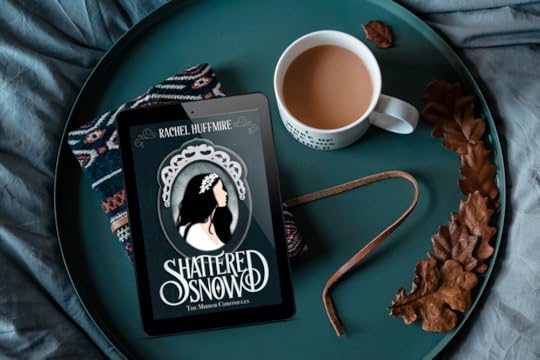
Four years ago, I woke up on a chilly January morning with a big smile on my face. After eight years of writing, querying, editing, and pitching stories... I was finally an author. I had over 72 rejection letters under my belt, 8 backlist manuscripts that had been shelved, but I had defeated the odds! They say success is where preparation meets opportunity, and I couldn't have felt more grateful. All my hard work had finally paid off and I had a story to share with the world.
My husband gave me a big hug and congratulated me on achieving my dream. His phone pinged and when he went to check it, was absolutely shocked...
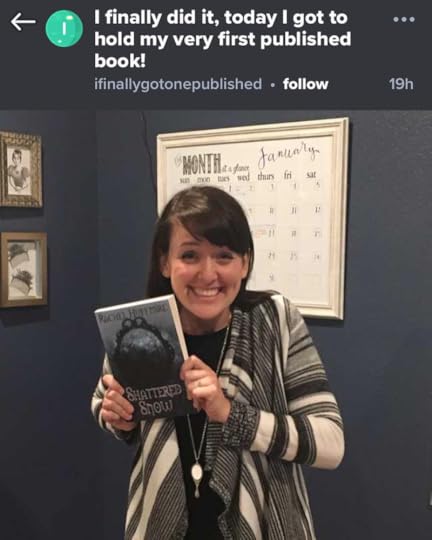
The night before, at midnight, he helped me post about my debut. And while we slept, that post had gone viral. It was named the top post of the day on Imgur, gaining over 150k interactions overnight and was named editor's pick of the day.
He has always been my top cheerleader, but that day I felt like he had brought the world with him to cheer me on.
I got a message from my publisher... "What on earth did you do?! Your sales are insane!" My debut book was selling in over 13 countries within the first 24 hours of release, hitting bestseller ranks in fairytale and time travel on Amazon.
I couldn't believe it. I was getting support and shout-outs from all over the world. I responded to each comment, replied to every message, and thanked every person who connected with me that day. It was a full-time job, but I couldn't believe how nice everyone was in supporting me, a stranger, in achieving my dream.
From there, the buzz just kept growing.
A German scholar reached out to me; Eckhard Sander. I recognized his name immediately. I had studied his research and included many of his findings in my novel. He was the leading expert on the truth behind Snow White—based on a German duchess named Margaretha von Waldeck. Using a colleague as a translator, he congratulated me on the book, thanked me for using his research, and told me if I ever wanted to tour Margaretha's castle, he would give me a personal tour.
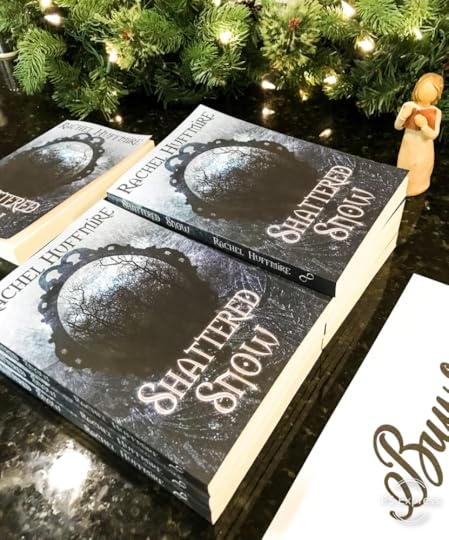
It felt like a fairy godmother had sprinkled magic dust all over my debut and sent it across the world in a magic carriage. I recognized that these amazing moments were coming from people who were kind and willing to celebrate with a stranger, me, because I had finally achieved my dreams. The world can be a very bright and supportive place.
That night, I had a release party with some of my local friends, and went to bed feeling complete gratitude. Yes, I had written a fairy tale, but kind people from around the world had literally turned my day into a real-life happily ever after.
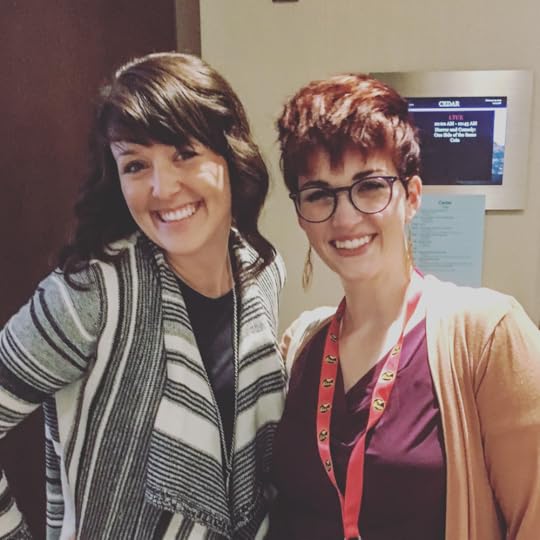
But, the pixie dust didn't stop there.
Not too long after, Deep Magic eZine contacted me and asked to highlight my novel in their upcoming issue.
One of their contributors, Charlie Holmberg (also one of my favorite authors) set up a live interview with me and I got to chat with her about books and fairytales.
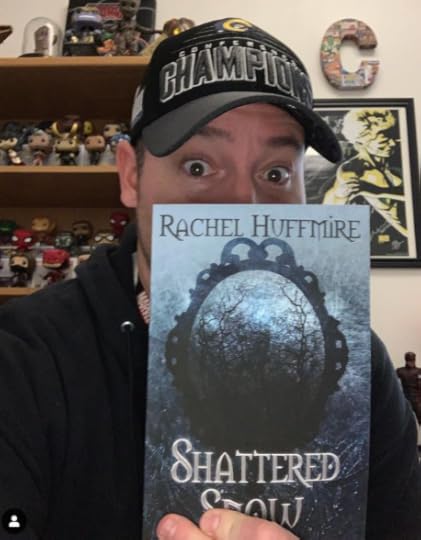
Brian Crosby, the creative director of Marvel themed entertainment, gave me a blurb for the back cover of my book and posted about my book on Instagram.
He said, "Rachel Huffmire is an exciting new voice who takes familiar ideas about fantasy and time travel and shatters those expectations! Literary escapism achieved!"
A few weeks later, a group of readers nominated Shattered Snow for a Swoony Award and it won best fairytale retelling!
Readers sent me pictures of my book in libraries, in their local bookstores--all because they had requested copies.
[image error][image error][image error][image error][image error][image error]Readers' Favorite posted a trade review that made me cry. It said, "This time-traveling fairytale will take your breath away as Shattered Snow is charming, addictive, original, and sets the bar for all fairytale retellings."
More readers nominated Shattered Snow for a Whitney Award, and it became one of five finalists in a YA speculative category, along with Allie Condie!
I could honestly go on and on about all the amazing things my readers have done to support me. And that's the biggest point I wanted to make in this post, is that none of this would have happened without the kindness and support of you, dear reader.
The fact is, I don't have an agent. I don't have a publicist or marketing director. Every bit of magic that I have experienced over the last four years as an author came from you.
So, I'm going to keep writing, keep building worlds all in the hope that I can turn that magic right back around and send it your way.
You are the best fairy god-mothers I could have asked for!
-Rachel

Haven't read Shattered Snow yet?
You can check it out by clicking here .
And of course, if you have any questions, feel free to drop them in the comments. I'd love to chat with you!
August 8, 2022
What is Hopepunk- and Why You Should Read It!

Just a few years ago, apocalyptic fiction was flying off the shelves like there was no tomorrow and dystopian novels were all the rage. Hunger Games. Maze Runner. 1984. The Giver. We just couldn’t get enough of it! After the quarantine hit, sweet romance, and “wholesome” stories saw a huge rise in popularity. Why? I think we all needed a healthy dose of positive escapism in our lives. Especially as wild science fiction turned into science fact. (Raise your hand if you’ve put down a book recently because it hit a little too close to home… Yeah, me too.)
Fiction has always been a great tool to help us process and experience the world in a safe environment. Unfortunately, the world isn’t always fluffy and bright and “wholesome”--we still have to deal with hard things. So, where is the happy medium between genres? How can we show the world realistically without watching depressed heros hit rock bottom as they fight dismal odds alone.
This is where hopepunk comes in.
Hopepunk is a genre that explores diverse characters banding together and fighting for radical positive change by using weaponized optimism. Hopepunk shows us a better way to come out victorious: with compassion and unity. Doesn’t that sound AWESOME!? I feel like not enough people know about hopepunk. So, I’m here to introduce you to what might be your next favorite genre!
I’m Rachel Huffmire and I’ve published 5 hopepunk novels in the last three years. I’m going to dive into what hopepunk is all about, what makes it so awesome, and why you should 100% start reading these stories right now.
 The Origin of Hopepunk.
The Origin of Hopepunk.The word punk itself denotes an identity rooted in rebellion. “Steampunk” quickly became the biggest of the “punk” genres in literature, but there are dozens of splinter “punk” genres. But in 2017, an author named ,Alexandra Rowland introduced hopepunk in a tumblr post that went viral. The definition of hopepunk is “a mood of gentleness or softness and a sense of self-awareness of weaponized optimism, with a worldview that fighting for positive social systems is a worthwhile fight.” (,https://en.wikipedia.org/wiki/Hopepunk)
Hopepunk is about coming together to disrupt a divided world, to defy pessimism, and create a brighter future. It’s not about one person trying to do it alone, it’s about a whole team adopting the same “good fight”, especially if they come from different backgrounds. I don’t know about you, but as soon as I heard about this amazing new genre, it sounded like exactly what I wanted to read. I wanted to see characters showing me this compassionate way through the crazy world we live in.
Why is Hopepunk Awesome?You have probably heard of Grimdark fiction: the idea that no one is wholly good, that pessimistic realism is best, and the strongest individual prevails.
Well, hopepunk is the opposite.
If Grimdark shows that the strongest individual will win, hopepunk shows that the most united group will come out victorious. Where Grimdark is full of flawed and self-motivated anti-heros, hopepunk is full of optimistic and generous heros. Here are just a few of my favorite tropes from hopepunk stories: (Read them and tell me you don’t want to read a story like this…)
Found family: This trop is about groups of friends who come to love each other like family even though they all come from different backgrounds and aren’t genetically related. Diversity: The best kind of unity is when individuals from different groups and backgrounds come together and work in harmony. And believe me, I would LOVE to see a lot more of that in the world. Showing compassion: I believe that true compassion takes courage. It’s not only feeling sympathy for others, but using that sympathy to spur us into action. And if everyone could truly learn compassion, what could the world become? Heroine’s journey: Now I could do another whole thing on this, and I probably will, but the heroine’s journey is a plot arc with life and death consequences for a protagonist. And just because it’s called a heroine’s journey doesn’t mean it needs to be a female. One of the biggest elements of this arc is that the protagonist needs to strengthen their relationships with others in order to succeed. Representation: Because diversity is such a critical element to these stories, we need to see characters from different backgrounds. You won’t find whitewashed casts in these books. Inner strengths: Everyone has strengths inside of them, but sometimes cultural views can make us believe our strengths are anything but. Compassion, Meekness, and Patience can be viewed as weaknesses, but in hopepunk, they might be the secret ingredient that enables our heroes to save the day.Examples of Hopepunk.While hopepunk has only been around as an official genre since 2017, there are lots of examples of hopepunk in literature. Here are a few of my favorite hopepunks:
Mistborn: Kelsier, Vin, and Elend.
The Lunar Chronicles: Cinder, Cress, Thorne, Winter.
Lord of the Rings: Frodo, Sam, Merry, Pippin.
The Fault in Our Stars: Hazel Grace and Augustus
The Night Circus: Celia, Marko, Chandresh, Tsukiko, Bailey, Poppet.
Can you think of any more? Drop them in the comments! I’d love to go explore their stories. But don’t drop the Avengers. Why not? Because they’re a group of alpha’s who despite sometimes working together toward the same goal, internally, they are are incredibly fragmented. We often see them fight each other just as much as the villain. The only close call hopepunk character in the Avengers is Black Widow.
In my own writing, I made sure I built the ultimate hopepunk team. In the not too distant future, a hacker has hijacked top-secret time travel tech and uses it to save unfortunate souls in the past because he wants to see the world become a better place. He assembles a team from all over the world and history, until he has a full cast of valiant hero’s working together to save the day from a dystopian-level threat.

If you want to read more about the story, you can check it out ,here. And as always, if you have any questions, drop them in the comments and I’d love to chat with you!
Till next time!
-Rachel
January 25, 2022
Rhodopis: The True Cinderella
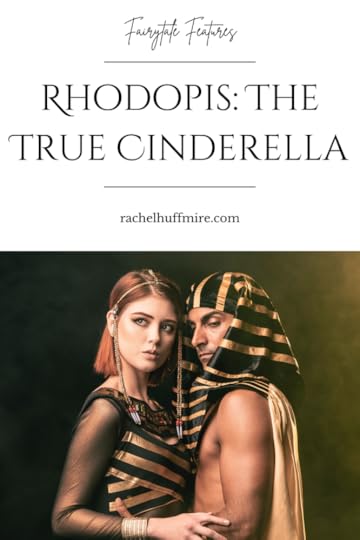
Often, when something is so far-fetched or unbelievably perfect, we accuse it of being a fairy tale. But, what if fairy tales were all rooted in truth?
You'd be surprised how many fairytales are based on historical figures: Snow White, Beauty and the Beast, the Little Mermaid... So, when I began research for my historical Cinderella retelling, imagine how excited I was to discover the story of Cinderella is another tale "inspired by real events". There are over 500 versions of the Cinderella fairy tale and the oldest goes as far back as Ancient Egypt! (Prince charming as a Pharaoh? Yes, please!) Here’s a bit of the surprising research I gathered before writing my novella.
Variations of CinderellaThe story of Cinderella has become so popular that it’s basically an archetype these days. How many times have you heard of an underappreciated character who discovers success referred to as "a Cinderella story".
There are over 500 different versions of this fairy tale from all around the world, including "Ye Xian" from ninth-century China, Cenerentola from Italy, and Le Fresne from France. The most popular edition is "Cendrillon" by Charles Perrault, who is known for creating the version with fairy godmothers and pumpkins that we are most familiar with today. When the Brother’s Grimm got a hold of it, however, they made a few changes that spun a bit of a darker tale: Exhibit A: cutting off step sisters' feet to make the glass slipper fit and birds pecking out their eyes at Cinderella’s wedding. Classic Grimm.
RhodopisThe earliest version of Cinderella is believed to be the tale of Rhodopis from ancient Greece. The Greek historian Strabo in the first century wrote about her life as a slave, and about how as she bathed in the river, an eagle stole one of her sandals from the bank and carried it to Memphis, dropping it in the lap of the Pharaoh. The king took it as a sign from the gods and sent men searching his kingdom for the owner of the sandal. Once she was found, the pharaoh married her.
Another Greek historian, Herodotus, also recorded information about a slave named Rhodopis that very well could be the same person. He described Rhodopis as a stunning Thracian courtesan named Rhodopis. She was captured and sold to a Greek man named Ladmon who lived in a Greek Colony in Egypt, called Naucratis. Ladmon owned a number of slaves, including a disfigured, yet cunning storyteller named Aesop. Yup, like the guy from "Aesop's fables".
 Cinderella Retold
Cinderella RetoldWhen I heard about Rhodopis and dove deep into the research on her life, I couldn’t help but feel sympathy for her. History is full of injustices, and though her story may have had a happily ever after, there were accounts of how heartbroken she was to leave Aesop. There are even a few accounts of how they had a deep and abiding love for each other.
I wished I could reach back and rewrite history and give her the exact happy ending she would have wanted. That's how my time travel fairytale retelling series, The Mirror Chronicles, was born. All of my retellings are alternate histories, based on the historic figures who inspired the fairytales. I have covered ,Snow White, ,Sleeping Beauty, and now, Cinderella with historically based characters.
If you’d like a free copy of my Cinderella retelling (it’s a novella), I’m giving copies away here. I’d love to know what you think!

Here's a little bit about the book:
Rhodopis is a Greek kitchen slave who longs for freedom. Persecuted by her master's conceited and beautiful daughters, Rho vows to ease others' burdens, never add to them. When the gods hear her prayer and send a mysterious woman to purchase her freedom, Rho believes the fates are finally smiling on her. But holding on to everything she's ever wanted isn't as easy as it seems. Rho will have to do everything possible to keep fate from slipping through her fingers.
January 18, 2022
How to Write Transportive Fiction
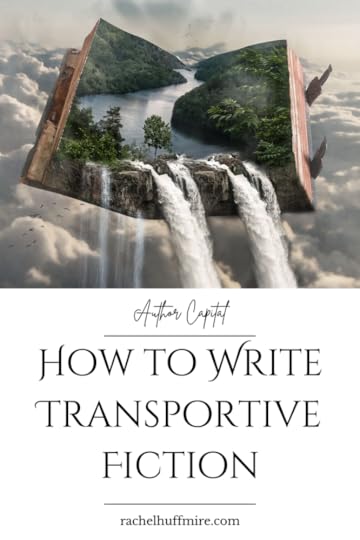
Have you ever finished reading a book and realized it was 2 AM? Then, you spent the rest of your week playing out the character's happily-ever-after because you're just not willing to let the story go yet? Finally, desperate to share your experience, you tried to tell someone the plot and felt like you just couldn't do it justice?
Yeah—me neither (*shifty eyes).
What is it about some books that transport us into an entirely new world? And, more importantly, how do we write like that?
This mini workshop will help you see how to envelop your reader into your world so completely that they won't be tempted to press that cute new bookmark they bought between your pages. Whether your reader is looking for escape or experience, writing a transportive novel will ensure that they get what they're looking for.
1. Begin with nouns:
Pull out your work in progress and find a page that is mainly description, not dialogue. Next, grab a colored pen (I'm working with purple today) and underline all the nouns on the entire page. Read them out loud. Do any of them repeat too often? Would a stranger be able to describe your setting based off these words or would it seem murky to them?
We use nouns in every single sentence. They hold a lot of power. If they're vibrant and specific, your writing will shine. If they're bland and generic, your story will fall flat. So, let's take a look at how to amp up those bland nouns.
Here's a sample sentence from the rough draft of my 2015 Nanowrimo novel.
"I drop a branch from the tree, watching it fall to the ground."
As you can see, those nouns are pretty generic. If we get more specific, it will give it a more cinematic quality.
"I drop a branch from the orange tree, watching the dried limb fall to the crackled dirt ."
The same structure, and yet it paints a different picture. Paired together with an entire paragraph of deliberate nouns, your reader will have no doubt about what they're seeing.
When choosing new nouns you want to keep your narrator in mind. Sure it would be easy to go to thesaurus.com and find fitting alternatives, but would your narrator use or know that word? Also, consider your reader. A rule of thumb for children is if they need help with more than three words per page, the book is too advanced for them. Use beautiful words that will stretch your reader, but don't overdo it. Sometimes simple is best.
2. Focus on your verbs:
Verbs need to be as focused as your nouns. Verbs are the glue that bind setting to character. Use verbs that make the character active in the scene rather than merely observing. The more your character interacts with the setting, the more your reader will sense the action themselves. Let's use that same sentence and see what we can do. Underline all the verbs and find active, vivid verbs to replace the generic ones.
"I drop a branch from the orange tree, watching the dried limb fall to the crackled dirt ."
"I ,toss a branch from the orange tree, and the dried limb ,shatters on the crackled dirt ."
Do you feel how that sentence is emotionally charged now? This is a moment of frustration for my character, so using strong verbs helps ramp up the tension. Plus, we got rid of a filtering verb that made the character experience the action instead of the reader.
Now that you've tried it yourself, share your sentence below! We'd love to see how it changed your writing!
3. Focus on what your character "feels".
Our life experience consists of taking in the world through our five senses, then producing emotions in response. I think it's interesting that both the input and output both use the word "feel".
For example:
We feel the soft kitten, then we feel happy.
We feel the room heat up, then we feel nervous about the electricity bill.
We feel the keyboard clicking beneath our fingers, then we feel like nothing can stop our wordsprint!
Utilize all five of your character's senses as they take in the world, and then show how it affects them internally. Then, your book will come alive for your readers. Tapping into your readers' own experience by using familiar senses will help them connect even closer with your characters. For example, mention the scent of "fresh pine" and they'll immediately pull an entire schema of images into their mind to add to your story without you having to say another word about it.
Finally, when your character interacts with their environment, let them react. Very few things in life elicit a neutral response. People are full of opinions. When your character feels emotional responses to the things they're coming up against in your story, your reader will get into their head space. They'll be able to empathize with what they're feeling.
Readers are hungry for engaging writing. They want to be swept away by vivid imagery, heartfelt emotions, and empathic characters. Utilizing these three tips will give your writing a different depth that will pull readers into your world. And when you finish, send us a note! We love to read what other people are writing!
Happy editing!
 Hi!
Hi! I’m Rachel Huffmire, I’m an author like you, applying these same principles to my own books. I have worked as a bookstore manager, acquisitions editor, the marketing manager for a small publisher, and now, I’m the founder of Author Capital, a coaching group that focuses on the business side of self-publishing. So, if you're ready to take your writing to the career level, click here to learn more about Author Capital's online courses and coaching packages.



